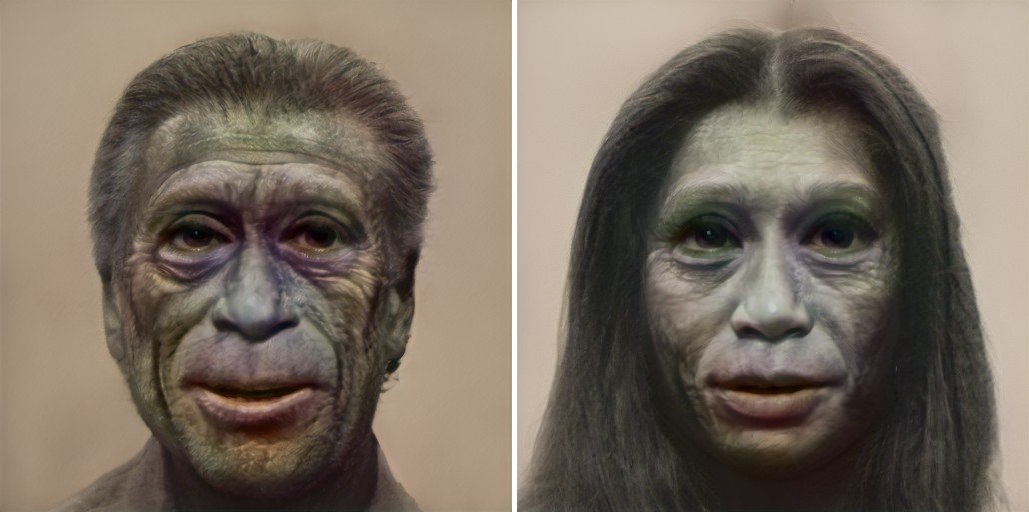Cynid Humans
[Fear Cliste Cynis]
Cynids, also known as "Neandermen" and "Northmen," are a minority human species comprising approximately 15% of the world's population, who have historically occupied the extreme northern regions of Eastern Heremonia.
Basic Information
Anatomy
The cynid body is humanoid in form, comprised of a thoraco-abdominal trunk, two arms and hands, two legs and feet and a head sitting upon a short neck, generally similar to the bodies of felids and siminids and incorporating similar physiological systems. However, cynids are commonly of a stockier and more robust build than both felids and siminids, with wider, barrel-shaped rib cages, wider pelvises and proportionally shorter forearms and forelegs. In addition, the cynid skull is larger than the felid or siminid skull and more elongated than the siminid skull, with an occipital protrusion. The cranial base and temporal bones are higher and more toward the front of the skull, the skull cap is flatter and the neck vertebrae are longer and thicker than in siminids.
Cynids walk erect on two legs, have opposable thumbs and lack an external tail. Like all humans, height, weight and body structure vary greatly among cynids, depending upon many genetic and environmental factors. The average adult height of a cynid male is approximately 1.69 yds. with females averaging approximately 1.61 yds. Average cynid weight for males is 199 - 229 pds. and for females it is 169 - 189 pds.
On average, cynids have a 10% larger brain than felids or siminids, with the greatest divergence occurring in the occipital lobe. However, due to their larger bodies, cynids have a lower average brain-to-body ratio than siminids, although it is slightly higher than felids.
Cynids walk erect on two legs, have opposable thumbs and lack an external tail. Like all humans, height, weight and body structure vary greatly among cynids, depending upon many genetic and environmental factors. The average adult height of a cynid male is approximately 1.69 yds. with females averaging approximately 1.61 yds. Average cynid weight for males is 199 - 229 pds. and for females it is 169 - 189 pds.
On average, cynids have a 10% larger brain than felids or siminids, with the greatest divergence occurring in the occipital lobe. However, due to their larger bodies, cynids have a lower average brain-to-body ratio than siminids, although it is slightly higher than felids.
Biological Traits
Cynids are strong and robust, possessed of superior strength and muscle force, and well adapted to cold climate. They are fast runners in a sprint, enjoying a greater lung capacity than siminids, but are less well adapted to endurance running. They have well developed low-light and distance vision capabilities, and an enhanced sense of smell.
Additional Information
Facial characteristics
As with all humans, cynid facial features are individually unique and identifiable. The cynid face is generally narrower at the top than at the bottom. The forehead is short and slopes back from a prominent bony brow ridge, below which are the eyes - larger, wider apart and deeper set than siminid eyes, and with very few exceptions dark brown in color. A very large and broad nose protrudes from the center of the cynid face, beginning at the center of the brow ridge, slightly higher than the siminid nose. The lower part of the face exhibits significant maxillary and mandibular prognathism, or a protruding upper and lower jaw, with a reduced chin and large mouth cavity containing teeth significantly larger than siminid teeth.
Cynids
Scientific Name
Fear Cliste Cynis
Lifespan
male: 57.7 yrs. female: 63.9 yrs.
Average Height
male: 1.69 yds. female: 1.61 yds.
Average Weight
male: 199 - 229 pds. female 169 - 189 pds.
Body Tint, Colouring and Marking
Cynid skin tends to be dark and leathery, varying from dark brown to lighter tan, and they are often referred to as having "swarthy" or "ruddy" complexions, with dark brown eyes and hair color ranging from light brown to black. Facial freckles are extremely common among cynids.



Comments